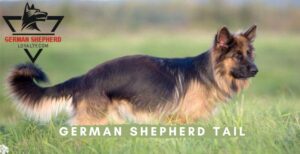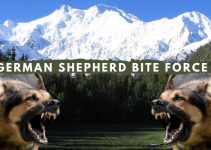” Tail wagging the dog” is an idiomatic expression that implies a worthless part is controlling the bigger as well as a more vital component. Paradoxically, the tail is not simply an irrelevant component for pets.
It is a functional part of their body. Some pets use their tails for keeping tree branches, while some utilize their tail to shoo away bugs. For German Shepherd tail, they use it not just for balancing but additionally for sharing their feelings.
Table could not be displayed.Contents
GSD Intro

A common German Shepherd tail length ought to be long enough that the tail end ought to reach the hock joint. It should be hanging with a slight contour like a cavalry sword when GSD is at rest.
The curve needs to be stressed, and the tail needs to be elevated when the canine is moving. But whatever a conventional GSD tail ought to appear like, it is necessary to understand that proprietors can utilize it as a device to comprehend their GSD’s existing emotion.
Understanding German Shepherd Tail Behaviors and Meanings
To better comprehend GSDs, owners should begin observing tail settings as well as movements. Up and down tail settings demonstrate how much energy they have.
While a GSD’s tail has right as well as left muscular tissue, it is instinctive for them to wag their tails a lot more on the right side for favorable feelings and also the left for adverse emotions. For example, A German Shepherd wagging tail a lot more towards the left side practically touching their bodies indicates they fidget.
Just how high they hold their tails, shows the state of mind they remain in. So, the greater, the extra motionless their tail is, the, even more, they are really feeling stressed out and can be very unforeseeable. Here are some tail positions, movements as well as what they imply.
- If a GSD wags its tail extensively like mad, it indicates it is really satisfied.
- If its tail is in a downward setting in between the back legs, after that it is upset or unhealthy
- A loosened up GSD’s tail is lowered and not hanging between the legs.
- They generally do this to save energy.
- A GSD wagging its tail slowly is a sign of confusion.
- Much like an afraid child concealing under the table, a frightened GSD will certainly conceal its tail in between its legs.
- An additional meaning would be an appeal not to be hurt.
- Hair rising on a GSD’s back suggests aggression.
- A tail positioned stiffly right out of its body suggests the dog prepares to eliminate.
- A more hostile GSD will certainly relocate its tail high up as well as over its back to launch a battle with an additional pet.
- Whenever A GSD will hang its tail low flat far from its body, it can be a sign of peace. They can be viewed as if observing the surroundings.
- The greater the tail position of a GSD is, the extra it insists confidence as if informing the world it is the one in charge. Often the tail can be seen crinkled.
- A GSD that holds its tail upright and tight means they are the pack leader.
- They can be heard barking regularly, signaling their owners also on little things.
Why do German Shepherds Chase Their Tail?
It is amusing to see young puppies or adult dogs chasing their tails. They try to capture their tails and also even roar when they encounter catching it. GSD’s are among the many pet breeds that are prone to compulsive tail-chasing.
There are lots of aspects contributing to these actions. By simply evaluating the reasons, proprietors can train their GSD to quit this behavior. Educating them as a puppy is an excellent beginning. In grown-up GSDs, the interruption can assist.
- GSD’s are big dogs so keeping them in a confined area will certainly cause them stress and anxiety, hence tail chasing.
- Lack of exercise, as well as task, will certainly cause them to chase their tails wider in circles and also in some cases in 8s.
- Giving them activities and making them “work” or exercise will decrease their dullness.
- Genes can likewise create these habits. The behavior might have been given by their moms and dads to them.
- Anxiety as well as the anxiousness will certainly make them chase their tail up until they hurt themselves.
- So it is extremely important to check for tension as well as stress and anxiety triggers.
Why does a German Shepherds Tail Curl?
An additional acquired hereditary fault that GSDs struggle with is the curled tail. A German Shepherd curled tail meaning it has a gay tail. Defined by a tail that is lugged higher than the horizontal level of the back, crinkling upwards, a gay tail is a hereditary mistake.
Because it is a hereditary fault, the possibility of fixing it is nothing. Unfortunately, some proprietors as well as breeders will certainly do anything for popularity and cash, so they will certainly select surgery. The issue is, surgery will not keep the “supposed” show high-quality pups from acquiring gay tail, as well.
The good news is, not all German Shepherd puppy tail curls. For some, it is simply a quirk that can be removed by training. Remote control training methods can be used to educate GSD show dogs to hold their tails in a certain position when standing. This technique will certainly require time and patience from the owner.
German Shepherd Tail Diseases and Possible Treatments
GSD tails are not simply a dimension of their present feelings. It can also be harassed by a variety of health-related issues, considering that they are genetically predisposed.
Anal Furunculosis
A persistent inflammatory condition of the skin under the tail as well as around the rectum is normally triggered by the ineffective reaction of the immune system and genes. But how GSDs bring their tail and also the thick layer around the anus may be instrumental. To prevent such disease from being passed down, breeding needs to just be in between untouched GSDs.
Skin Infection
It is extremely challenging to deal with skin infections on a GSD’s tail. Tails normally don’t have that much additional skin, so this area is a lot more prone to infection. German Shepherd hair loss tail, Itching, and chewing are caused by allergies which may eventually come to be infected if left untreated.
Cuts as well as scuffs or even canine bites on the tail are all possible reasons for infection, as well. Topical antibiotics look tempting for GSDs that they will certainly keep on licking their wounds. Oral antibiotics carried out in proper dosage will certainly be the best option.
Limber Tail Syndrome
Limber Tail Syndrome is likewise called Acute Caudal Myopathy, Cold Tail, and also Broken Tail. It is typically brought on by overwork, injuries, or investing too much time playing in cold water. Tail muscle mass becomes swollen and also unpleasant within 24 hours adhering to exposure to freezing cold water.
Long-term confinement in confined areas may also cause this disorder. Diagnosis for Limber Tail Syndrome is great as it will certainly disappear on its own. Using a cozy compress will certainly minimize the swelling and the pain, but some veterinarians might suggest painkillers.
Why Is the Bushy Tail Important to the German Shepherd Dog Breed?
As the American Society for the Prevention of Cruelty to Animals (ASPCA) mentions, the bushy tail is among the characteristics most acknowledged about GSDs.
The tail is so crucial that it figures prominently in the German Shepherd official breed standard (appearance and also conformation guidelines) registered with the American Kennel Club (AKC).
The main breed standard for the GSD defines precisely what the German Shepherd canine’s tail must look like in adulthood. Here are the main points described in the type criterion:
- The tail should be bushy.
- The tail ought to prolong bent on the hock joint (be held away from the body to where it is identical with the ankle joint).
- The tail should await a small contour “like a saber.”
- The tail should not be short or docked (cut).
Dog owners who intend to show their German Shepherd in pet shows or conformation competitors risk being invalidated or having points subtracted if their dog isn’t able to meet every appearance standard in the breed requirement.
Did You Know the GSD Has Different Breed Lines?
While on the one hand, every German Shepherd canine active today can map its lineage back to the initial Captain von Stephanitz dog type line to some degree, there has also been a fair bit of aberration in modern GSD breeding.
There are 2 main distinctions in today’s German Shepherds: the show line as well as the functioning dog line.
As one German Shepherd breeder defines, there are 5 sub-types from these 2 main lines:
- American show GSD.
- West German program GSD.
- West German working GSD.
- Czech working GSD.
- DDR (Deutsches Demokratische Republik)/ East German working GSD.
This is very important to know if you are acquiring a German Shepherd dog for a specific objective or objective.
As an example, allow’s claim you intend to reveal your GSD in competitions for conformation. In this situation, you would be wise to pick a dog breeder that specializes in either the American or West German program GSD breed line.
This is because program lines are bred to look and conformation. These are the canines that are more than likely to grow up as well as establish the hallmark German Shepherd long bushy tail.
On the other hand, working GSD lines are reproduced for character and also personality attributes. The look is always secondary.
As you can see in these pictures from the dog breeder pointed out right here previously, the working dog type lines usually have thinner tails as well as often the tails are curled, which can lead to points off or disqualification in the show pet ring.
When Will a GSD Puppy Tail Get Bushy?
Earlier here we discussed that German Shepherds as a general policy can take a longer amount of time to mature. As this German Shepherd owner online forum string indicates, this can really puzzle GSD proprietors.
The best method to recognize the length of time your German Shepherd will certainly require to reach their full grown-up dimension, as well as conformation, is to find out as much as you can concerning the moms and dad canines.
As the main GSD type basic discusses, adult German Shepherds can range in dimension from 65 to 90 pounds and also stand anywhere from 22 to 26 inches tall (paw pads to shoulders).
As well, relying on the breed line your GSD young puppy originates from, it can take anywhere from 18 months to 36 months to totally develop.
This is necessary to understand since the bigger your young puppy’s moms and dads are, the longer your puppy is most likely to require to reach their full adult size, weight, layer as well as tail.
Too, the type line can affect the time to maturity, with the East German and also Czech lines taking the longest generally to develop.
If your GSD young puppy has gotten to a year and also a fifty percent old as well as the tail still isn’t bushy like you expected, it may be that your pet comes from a breed line or from moms and dads that do not have the large bushy, cozy tail quality.
Alternately, maybe that your pup simply originates from a type line that takes longer to develop as well as you have a bit longer to wait prior to that fluffy, bushy tail fully expands in.
The German Shepherd Puppy Coat Is Quite Different Than the GSD Adult Coat
Something else lots of new German Shepherd owners do not recognize is that the German Shepherd puppy coat is fairly different than the layer these pet dogs will have in their adult years.
The young puppy layer is much softer and also fluffier. It is also single-layer as well as is missing the 2nd shielding under-layer these pet dogs expand as grownups.
The young puppy coat will certainly start to shed out around the 4 to the six-month mark. The dropping out duration signals the start of the grown-up coat expanding in.
The adult German Shepherd coat is a double layer. There is a much longer, rugged, waterproof external layer that varies from tool to long. Then there is the insulating, soft inner layer that lays near to the skin.
When the pup layer begins to lose out, this is the moment when you can anticipate to see your young GSD’s tail obtaining longer and also thicker also. However, this entire procedure can spend some time and also depend on the size and also type line, as we highlighted here earlier.
Each year after that, your German Shepherd will do something legendary called “blowing coat” once to twice a year. This often happens at the altering of the seasons.
When the climate changes from wintertime to spring or fall to winter, this prompts the insulating under a layer of your dog’s layer to completely drop out and grow back. This is really vital for your pet dog’s protection but can momentarily generate an extremely thin tail.
This is nothing to worry about. Your dog’s thick, bushy tail will certainly quickly expand back as the new coat grows in.


